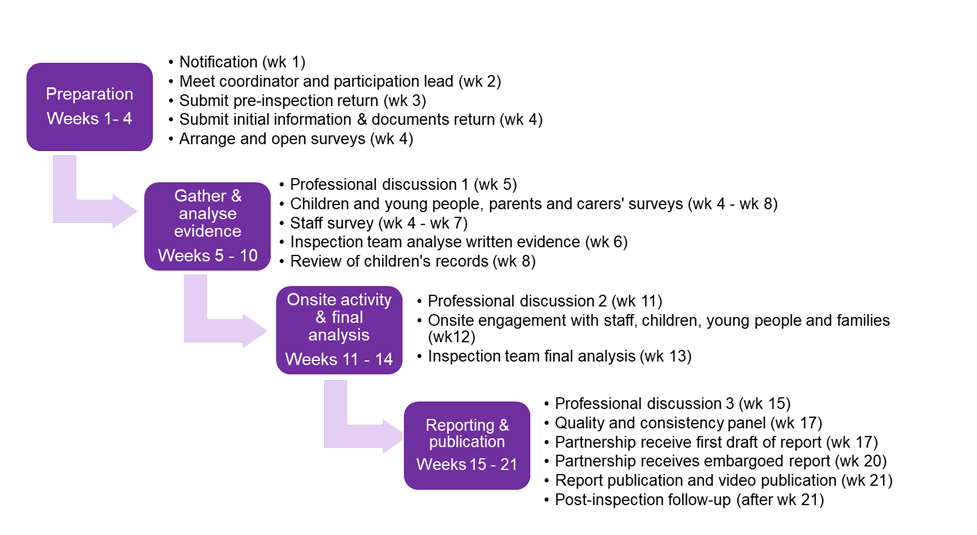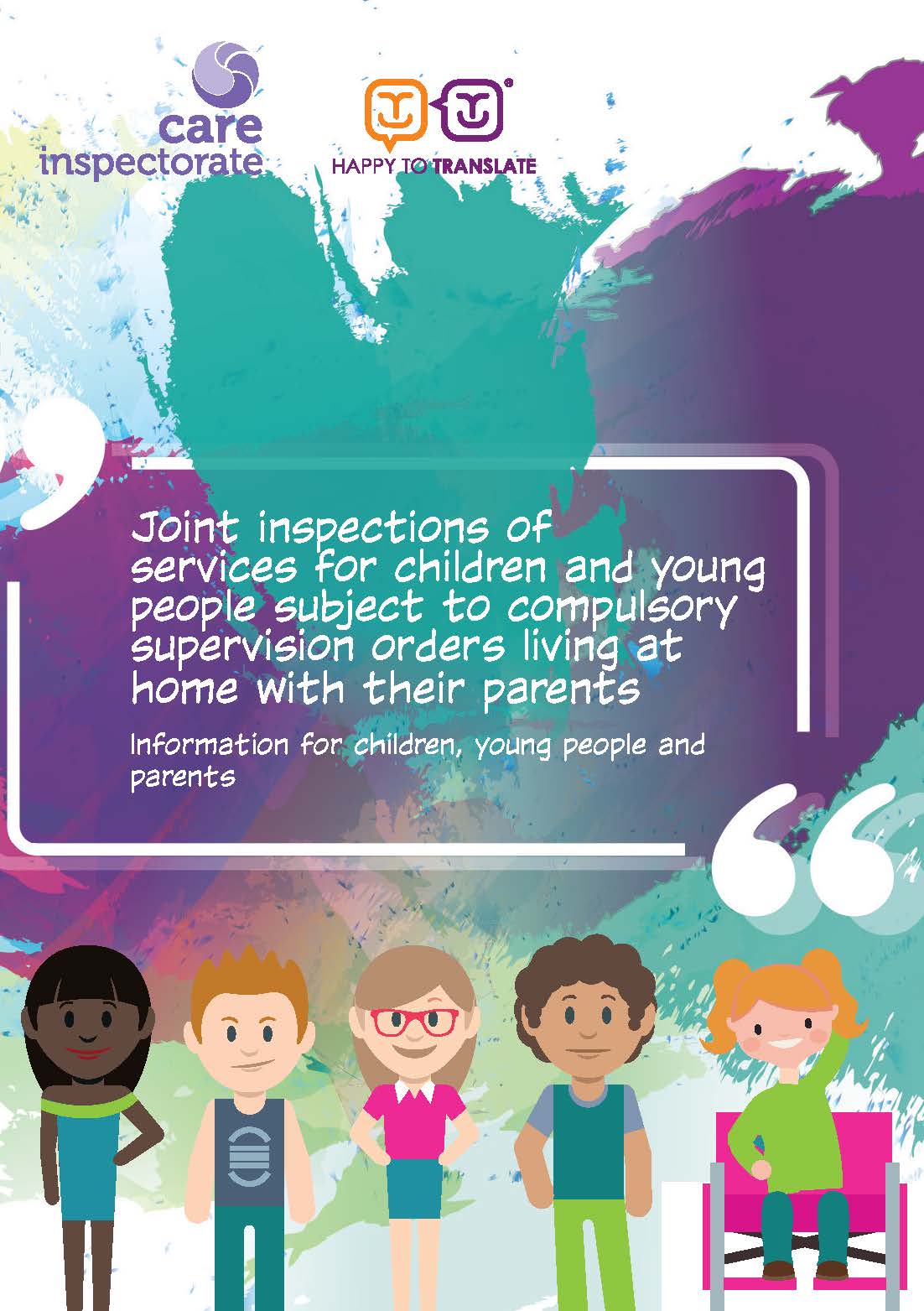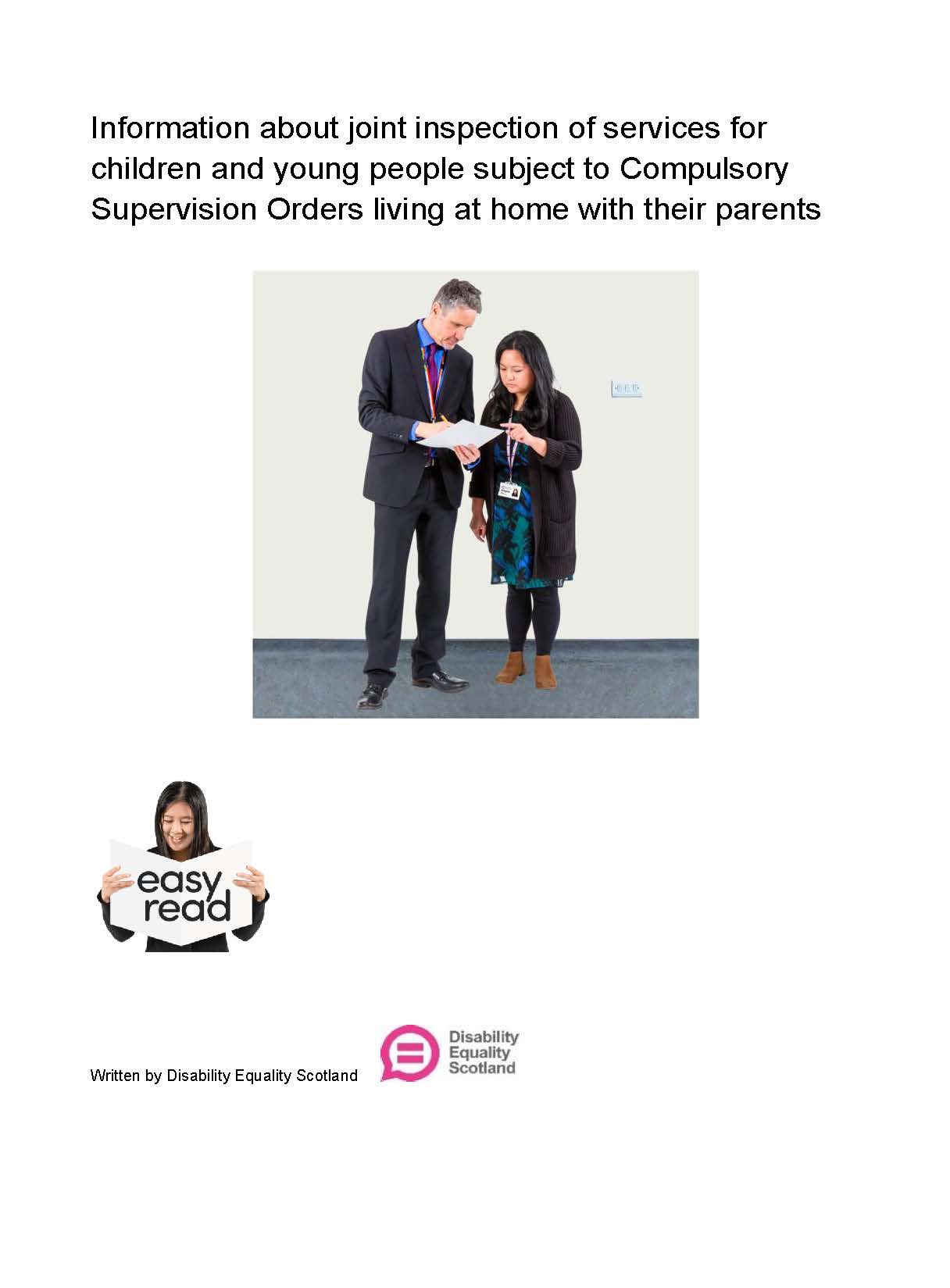Community justice partnerships: supported and validated self-evaluation
Between 2018 and 2020, we worked in partnership with His Majesty’s Inspectorate of Constabulary in Scotland (HMICS) to support the implementation of the national community justice model through a validated self-evaluation approach. We carried out assurance activities across the following five community justice partnerships, one of which incorporated three local authority areas:
- North Lanarkshire (did not involve HMICS)
- Clackmannanshire
- Ayrshire (North, South and East)
- Shetland
- East Lothian
In summary our activities included:
- support and guidance from a strategic inspector for partnership areas to undertake self-evaluation
- submission of a self-evaluation by the partnership
- analysis of the submitted documents by the Care Inspectorate/HMICS team
- follow-up activities with the partnership to explore any areas of uncertainty (these included visits, interviews and focus groups)
- verbal feedback on the findings to each partnership based on the analysis of all the evidence gathered
- publication of the validation letter.
Thematic review of prison-based social work
In July 2023, we commenced a joint thematic review of prison-based social work services, in partnership with His Majesty’s Inspectorate of Prisons in Scotland (HMIPS). Phase 1 of this thematic review considered the strengths and challenges in the governance, leadership, and accountability of prison-based social work services in Scotland and highlighted areas for improvement. The review sought to explore:
- governance, leadership and direction
- partnership working, including commissioning arrangements and resourcing
- policies, procedures, and guidance
- management and support of staff
- performance management and quality assurance
As part of the review, we gathered the views of people in custody who had been working with prison-based social work services. Other activities included:
- a series of scoping meetings with stakeholders including the Scottish Government, the SPS, Social Work Scotland, the Risk Management Authority, and Community Justice Scotland
- a review of relevant strategies, policies, guidance, procedures and other documentation relating to prison-based social work services
- a staff survey distributed to all prison-based social work staff
- focus groups and interviews with key partners.
We published a report of our findings in April 2024. The report contains more details on the methods we used.
Evaluating the quality of prison-based social work practice was outwith the scope of this first phase of the review. Within the report, a commitment was made to a further phase of work in this regard. In the longer term, this will aim to consider the quality of prison-based social work practice, the efficiency of collaboration with community-based justice social work services, and effectiveness in delivering intended outcomes for people.
Community justice social work: inspections of community payback orders
Between September 2018 and November 2020, we completed five inspections of justice social work services with a particular focus on community payback orders in these areas:
The inspection guide for these inspections summarises the activities involved.
Information for staff
One of the foundations of the Promise is about supporting families to stay together and emphasis is placed on the importance of providing timely support to ensure children can stay in their families wherever it is safe to do so. By considering the experiences of children who are subject to compulsory supervision orders and living at home with their parents, we aim to better understand what is helping to improve outcomes for children and young people and what is getting in the way.
- What we will look at on inspection
- How long these inspections will last
- What activities we will undertake
- Reporting
What we will look at on inspection
By considering the experiences of children who are subject to compulsory supervision orders and living at home with their parents, we aim to better understand what is helping to improve outcomes for children and young people and what is getting in the way.
Our three key lines of enquiry are:
- Children and young people are well supported to live with their families. This support helps to keep them safe, overcome difficulties and makes a positive difference in their lives.
- The services children and young people receive are well planned and delivered in a way which is compassionate and by staff who put children and young people at the heart of decision-making. People in the workforce ensure that children, young people and parents are meaningfully listened to, heard and included.
- Leaders and managers work well together to create and maintain a joined-up system of care which delivers the right services to each child at the right time. This provides children and young people, their parents and the workforce with help, support and accountability.
In our inspection report we will consider these three key lines of enquiry. We will evaluate four quality indicators from our quality framework using the six-point scale. These are:
- Quality indicator 2.1: Impact on children and young people
- Quality indicator 5.3: Care planning, managing risk and effective intervention
- Quality indicator 5.4: Involving individual children, young people and families
- Quality indicator 9.2: Leadership of strategy and direction
Children and young people have told us about the importance of being able to experience sincere human contact and enduring relationships. Our approach therefore looks carefully at how well services and systems are organised so that children and young people can experience continuity in their care and develop and sustain lasting relationships. Our inspections also consider whether legal measures are being used appropriately to achieve security and stability for children.
Staff who are well trained and who feel valued and empowered, are more likely to be able to provide high quality services for children and young people. We therefore explore how well staff are supported to carry out their task. Our joint inspections will look at the services provided for them by health workers (for example school nurses, health visitors and doctors), social workers, police officers and lots of other people who work with them and their families.
We know that partners recognise that assessment and planning are critical to ensure the safety of, and improving outcomes for, children and young people. However, we also know that performance in assessment and planning is not as consistently strong across the country as it needs to be. We will look to see if robust quality assurance and high-quality reflective supervision are in place to support these important processes.
Strong collaborative leadership is essential and challenging in the context of providing high quality public services in an integrated landscape. We consider the effectiveness of leadership and how well leaders can demonstrate what difference they are making to the lives of children and young people.
Background information
The focus of our joint inspection - children and young people subject to compulsory orders and living at home with their parents
In August 2025 we published a review of findings from the joint inspection programme 2021 - 2025 which summarised and reflected on the findings from joint inspections of services for children and young people at risk of harm within 15 community planning partnership areas. Aside from joint inspections, we also undertook a series of thematic reviews on specific topics including secure care; cross border placements; services for disabled children and young people and services for care experienced young people.
The last time that we carried out joint inspections of services for children who are looked after was between 2018 and 2020, in our joint inspections of services for children in need of care and protection. In our overview report we noted that:
- Children and young people subject to compulsory supervision orders and living at home with parents experienced the least improvement in their wellbeing, when compared to children looked after away from home in kinship, foster or residential care.
- Partnerships struggled to find the evidence to demonstrate tangible improvements in the wellbeing of looked after children and young people and in understanding performance trends concerning different looked after groups.
- There had been some progress in narrowing the educational attainment gap between looked after children and their peers, however, it remained too great.
- Not all care experienced children and young people had the same opportunities to share their views and meaningfully influence service delivery.
- The collaborative leadership of child protection was much more robust and embedded than that for corporate parenting.
There are also a range of other evidence sources that indicate there is a need for further exploration of the impact of services for children and young people subject to compulsory supervision orders and living at home with parents. In particular, Scottish Government’s publication: “Educational Outcomes for looked after children 2022/23” evidences lower school attendance rates, higher school exclusion rates, lower positive destination rates and poorer attainment rates for children looked after at home, when compared to the wider group of looked after children.
By considering the experiences of children who are subject to compulsory supervision orders and living at home with their parents, we aim to better understand what is helping to improve outcomes for children and young people and what is getting in the way.
Our three key lines of enquiry are:
- Children and young people are well supported to live with their families. This support helps to keep them safe, overcome difficulties and makes a positive difference in their lives.
- The services children and young people receive are well planned and delivered in a way which is compassionate and by staff who put children and young people at the heart of decision-making. People in the workforce ensure that children, young people and parents are meaningfully listened to, heard and included.
- Leaders and managers work well together to create and maintain a joined-up system of care which delivers the right services to each child at the right time. This provides children and young people, their parents and the workforce with help, support and accountability.
How long these inspections will last
Our inspections last for a number of months. We collect information about the area before we visit it. This helps us to understand what happens there and what is affecting the way that services are being provided.

Preparation (weeks 1-4)
- Week 1 - notification
- Week 2 - meet coordinator and participation lead
- Week 3 - submission of pre-inspection return
- Week 4 - submission of document return
- Week 4 - arrange and open surveys
Gather and analyse evidence (weeks 5-10)
- Week 5 - professional discussion 1
- Weeks 4-8 - children and young people, and parents and carers' surveys
- Weeks 4-7 - staff survey
- Week 6 - inspection team analyse written evidence
- Week 8 - review of childrens records
Onsite acticity and final analysis (weeks 11-14)
- Week 11 - professional discussion 2
- Week 12 - onsite engagement with staff, children, young people and famileis
- Week 13 - inspection team final anaysis
Reporting and publication (weeks 15-21)
- Week 15 - professional discussion 3
- Week 17 - quality and consistency panel
- Week 17 - partnership recieve first draft of report
- Week 20 - partnership receives embargoed report
- Week 21 - report publication and video publication
- After week 21 - post-inspection follow up
Information for children, young people and families
What you think really matters. If we are inspecting your area, and you have experience of services, you may want to speak to us about the help that you have been getting.
What you tell us will help us find out what is working well and what could be improved about the care and support for children and young people. At the end of the inspection we will write a report and we will feedback to children and young people about what we have found.
Please review our privacy notice.
Information for children, young people and parents
Information for parents – easy read



